Life Cycle Stages Of Custom Software Development
The 21st century is pragmatically running on the reins of technology. All the businesses, be it start-ups or well-established enterprises completely rely on software development to operate online and uplift their market presence.
Moreover, customization of software provides a tremendously organized workflow making the companies’ operations conducive to natural efficiency. Then be it for an online banking sector, healthcare professional, or any other business vertical.
But, as a matter of fact, software that is customized to incorporate specific features certainly requires thorough planning and a set of protocols to follow. This entire process is termed as Software Development Life Cycle (SDLC). A custom software development company that skimps on any of these life cycle steps unintentionally invites bugs in the software.
Hence, if you are one such customer looking for a reliable vendor, it is imperative for you to have a deeper understanding of the complete process that encompasses software development.
Read on to understand everything about SDLC.
What is the Software Development Lifecycle (SDLC)?
Software development life cycle is a collation of 7 steps that helps an organization to sail hassle-free through the various stages of development. This step-by-step process aligns the project’s demands, budget, deployment time, and quality assurance to ensure the delivery of a robust product. Each of these stages is, however, dependent on the type of development model (Agile, V-model, Waterfall, RAD ) a company chooses for its operations.
What are the 7 stages of SDLC?
Ideation and Planning
As Earl Nightingale rightly said – “Everything begins with an idea.”
A well-thought idea becomes the cornerstone of every project and it requires a lot of brainstorming to implement that idea in an effective way. Thus, strategic planning forms the primary phase of SDLC which includes determining the availability of resources, type of methodologies to be followed, the scope of the project, development challenges, and its cost. Besides that, the planning stage also helps in anticipating the possible impediments in the project and in taking necessary measures to surmount them.
Furthermore, during this initial phase, a software development company gleans information from their customers to recognize their expectations and problem points. This in turn helps the development company to optimize the flow of their operations.
Requirement Analysis
Also known as feasibility analysis or defining stage, this step involves 3 stages.
- Requirement gathering – It is one of the most crucial steps in requirement analysis to deliver the end product exactly as expected by the customer. In this step, the business analyst garners the minutest details of the requirements from the client in the exact form they need. It is also a common practice to involve stakeholders in this step to avoid any discrepancies between the client’s expectations and the end product. These stakeholders could be software programmers or quality control engineers, etc.
Example of requirement gathering – Suppose a user asks a company to develop software so he can view his staff’s presence, then the business analyst must ask him whether it is for calculating salary or merely for checking if the employee is on leave. Or, for both.
- Requirement analysis – Now that the information is collected, the next step is to analyze the gathered data. Various stakeholders or people delegated for the task then sit together to brainstorm the functional and technical aspects of the project. The feasibility of the requirements put forward is then measured to eliminate any sort of ambiguity in the plan.
Example of requirement analysis – the customer, in addition, may ask for a feature that allows him to gauge the performance of each employee and the number of hours he/she spent in the office.
- Documentation – After a complete analysis of the functionality of the project, the finalized plan is documented into a contract known as Software Requirement Specifications (SRS). This document contains the risk mitigation solutions and quality assurance plans.
Design
Once the SRS is prepared, software architects refer to this guide in order to prepare two types of design documents:
- System Design Specification (SDS) – has logical design, and
- Design Document Specification (DDS) – has a physical design.
Some of the design examples which these documents contain include – data-flow diagrams, meta-data, pseudo-codes. SDS and DDS are then reviewed by the stake-holders for – assessing the risks, flexibility of the design, product strength, time, and budget constraints. The design that satiates all the conditions is finalized and propelled forward for the programming phase.
Coding/Implementation
The coding phase forms the foundation of the entire software development and is typically the lengthiest process. Software developers meticulously produce source code to meet the design requirements specified in SDS and DDS. It is also imperative for the programmers to align to the demands of the stakeholders. Once the design is produced and the functionality of the solution is established, the product (software) then enters the testing phase.
Testing
After the source code is ready, the next phase of testing those codes starts. Testing is usually a cycle. When a code is prepared, the developers test the code for its functionality. Then that code goes through the testers who use various frameworks and white/black box methodologies to check the code at multiple levels. Program testing, in-house testing, module testing, user-end testing are some types of testing conducted by experts that ensure the software is bug-free and has a smooth flow. If the source code has errors, the software goes back to the development mode. Thus, testing and development work in loops.
Deployment
The newly created software is now installed on the cloud for the client to use. At this stage, the software components are integrated to achieve a functional solution. Oftentimes, the deployment is staggered in case the software is quite complex. Once the software is deployed, it is available for the end-users and analysts.
Operations and maintenance
Operations and maintenance is the final phase in the software development lifecycle where the end solution is at the user’s discretion. Feedback obtained from the end-users is then used to upgrade the software with enhanced features or improved performance. This stage is also used to procure new requirements from the customer.
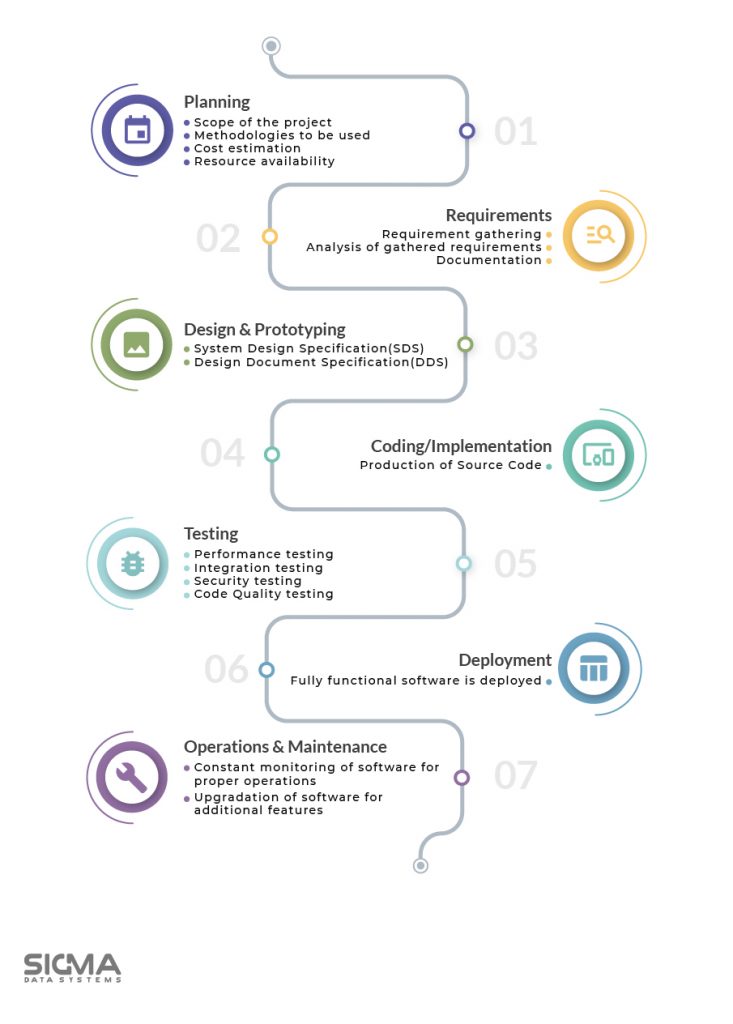
Software Development Models
Software development models are a set of frameworks that aid in structuring, planning, and managing the, otherwise, tedious development process. These models not only help developers to carry out the development process strategically but makes it effortless as well.
Significance of Software Development Methodologies:
- Provides a roadmap to manage the scope creep properly
- Eliminates customary development issues
- Engages the customers by keeping them informed
- Gives clarity and enough time for alterations
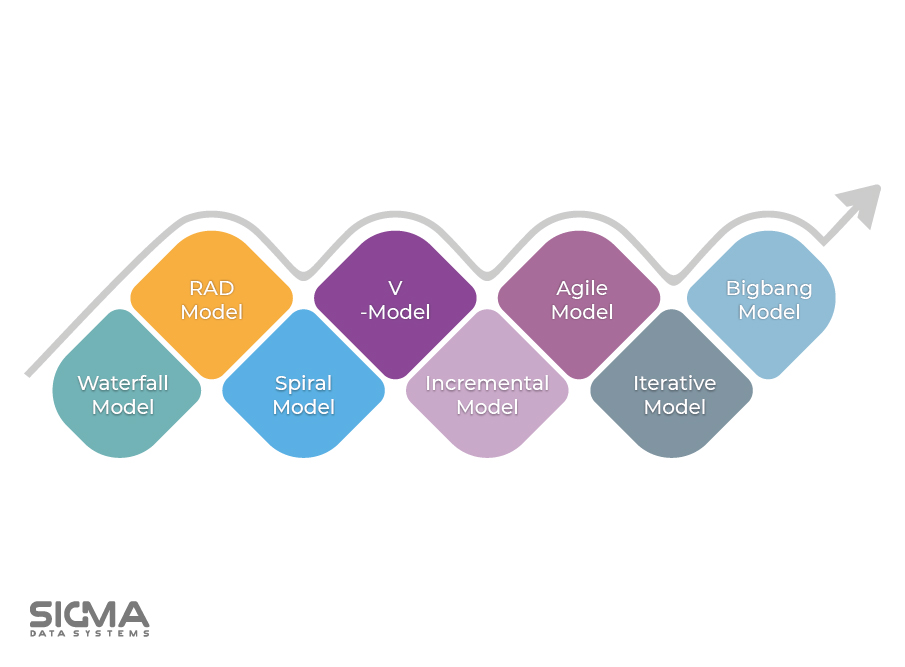
Here is an overview of some of the most popular and reliable models that drive the complete development procedure.
Waterfall Model
It was one of the first models introduced by Winston Royce in 1970. This model is segregated into sequential stages that work as a cascade. With no overlap between any of the phases, this model proceeds with step-by-step documentation and deliveries. Furthermore, this method ensures quality assurance at each stage. The project doesn’t move further unless the previous stage is developed completely and tested thoroughly.
However, this model does have its downside. One cannot evaluate the end results which risks the efficacy of the entire project.
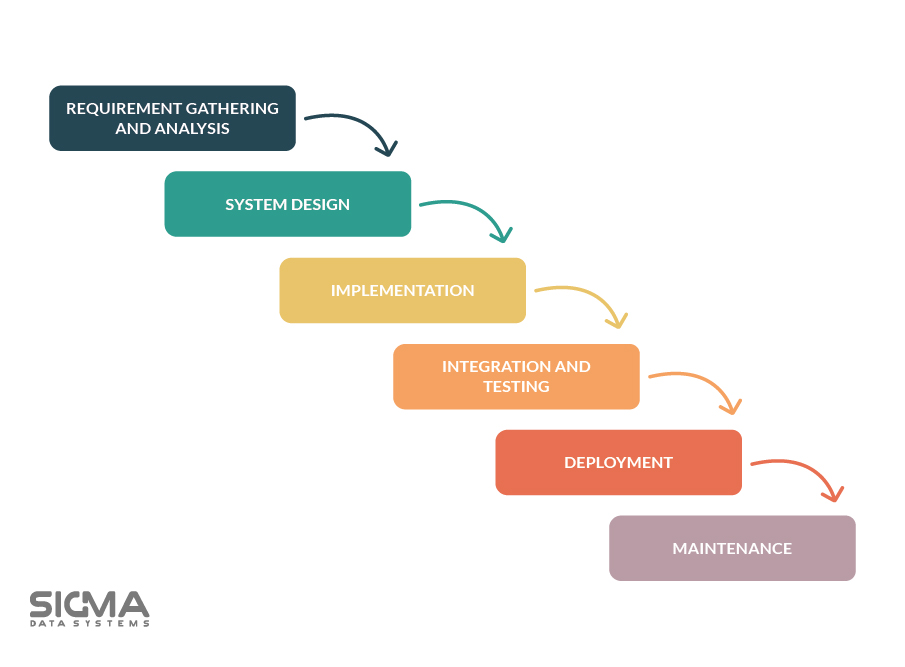
V-Model
V-model is an augmented waterfall model where each coding stage is synchronized with the testing phase. Each phase is verified and validated by means of test cases and test plans are generated at every stage. Due to this, bugs in code, architecture, and documented requirements are minimized which makes the V-model more robust.
The only drawback of this model is that developmental changes and their implementation prove to be heavy on pockets.
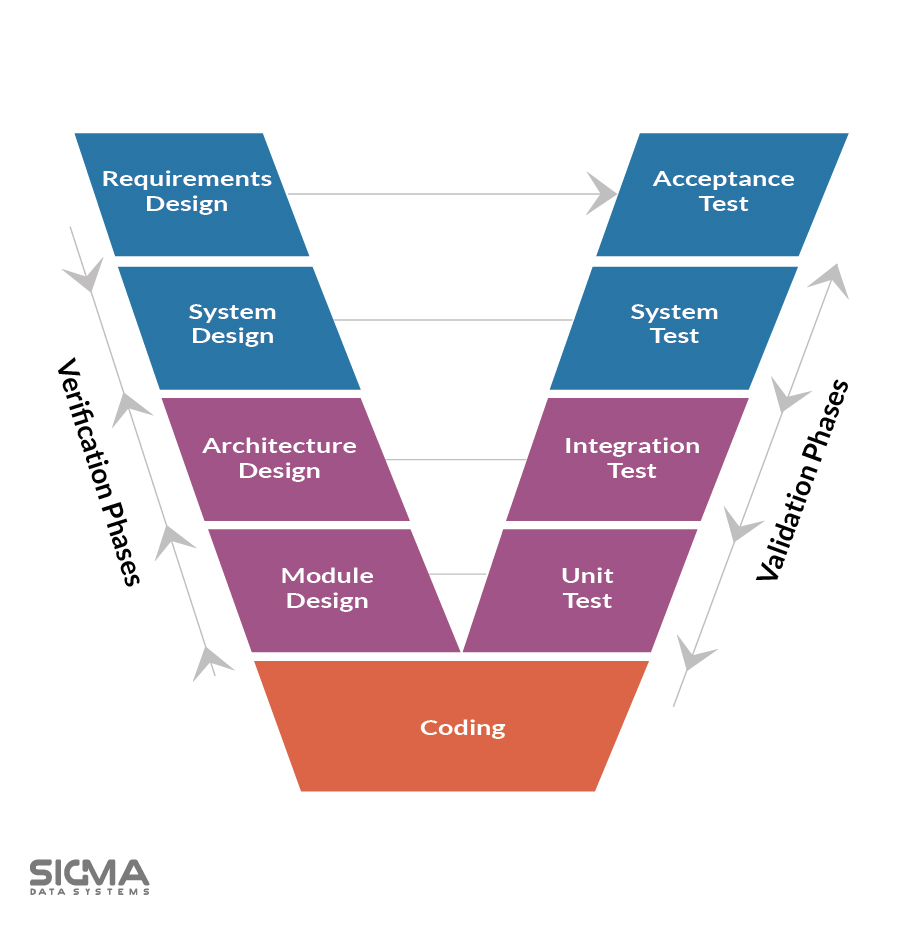
Iterative Model
Iterative model, as the name suggests, works in iterations. The development is carried out in parts and the changes can be incorporated within the development course. However, the model restricts any major alterations to avoid complexity and wastage of time. It is, therefore, important to proceed meticulously with the specified requirements.
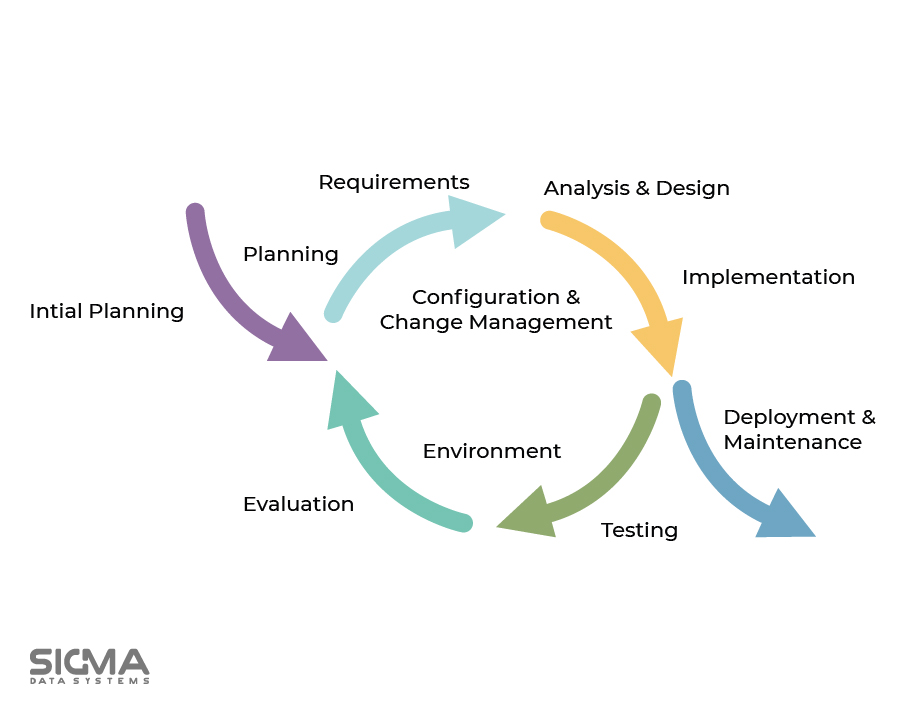
Spiral Model
This model works in a cycle and deeply assesses the risks. Hence, for this kind of a project, it is imperative to have good risk evaluation analysts. The process in this kind of model starts with defining the objectives and limitations of the software. It is followed by the creation of prototype and risk evaluation and the development continues in a spiral manner. Hence the name.
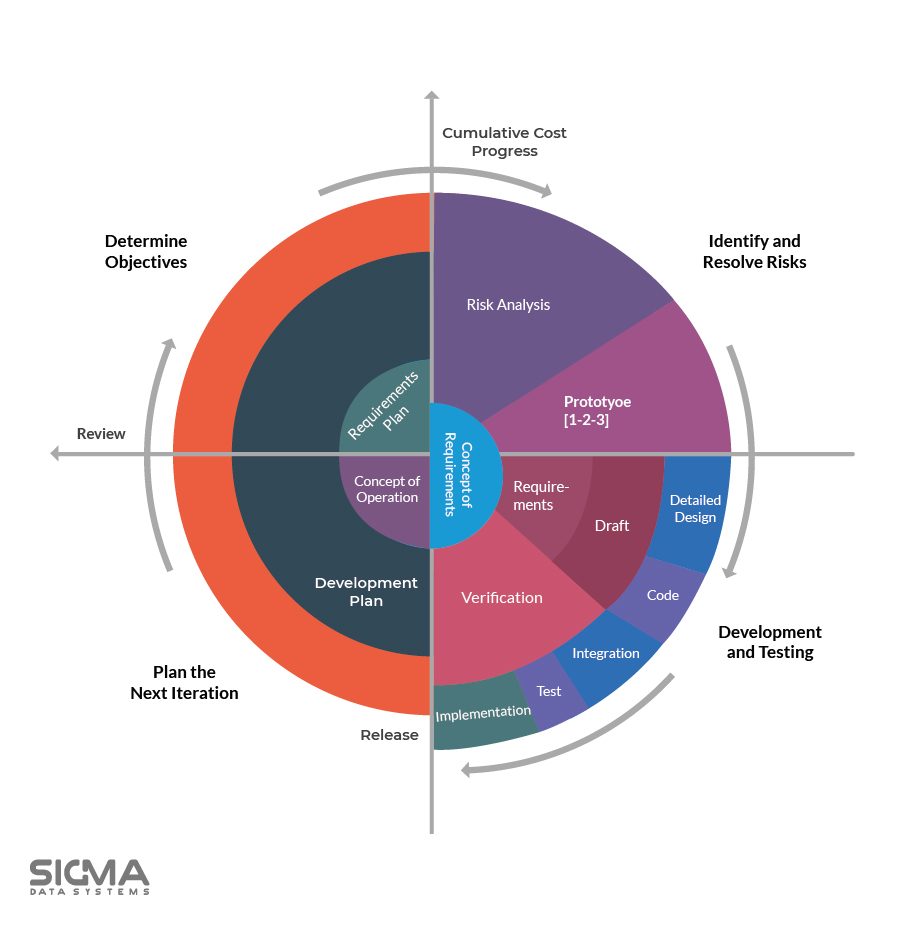
Agile Model
Agile model is a collation of Scrum and Kanban methodologies that revolves around iterative development. This model focuses more on software development and testing to deliver the functional part quickly, which in turn, ensures quality. Additionally, in Agile development, the teams work in collaboration with each other and there is frequent interaction with the clients. Due to this constant involvement of customers with the development team, the product bugs are fixed simultaneously and it becomes easy to incorporate additional features if need be. On the flip side, due to multiple iterations and people involvement, it becomes difficult to gauge the budget of the overall project. Moreover, it also consumes a lot of time to provide the final software.
A Comparison Of Agile Methodologies
Frequently Asked Questions About SDLC
1. Why is SDLC important?
- SDLC is important in software development to disintegrate the whole process into parts in order to make it more workable and deliver results faster. Apart from that, SDLC provides structure to the process to make it operational and efficient. It lays the foundation for determining the project goals, eases iteration management, and simultaneously helps measure project performance. Checkpoints and consequent validations at each stage make this process all the more quality-driven.
2. What are the problems you can face in the SDLC process?
- Project’s time management can be the biggest issue in SDLC. An approaching deadline can often cause the phases to be overlooked.
- Poor requirement analysis and vague goals can drag down the entire process due to failure of delivering the expected results.
- Improper allocation of resources and their responsibilities can lead to complexity and may adversely affect the productivity of the team.
- Lack of risk assessment and problem anticipation can impede the progress, hampering the scheduled activities and discouraging the team as a whole.
3. Which phase in SDLC is the most important?
- Planning phase is the most significant stage in the software development life cycle as it forms the foundation for the rest of the stages. It is at this stage the feasibility of the project is determined and the plan for process management is laid out.
4. Which SDLC model is the best?
- Agile is so far the best model in SDLC because it is quite flexible to change management and combines incremental and iterative approaches. Moreover, the agile development process requires less resources compared to other stages in SDLC.
5. Which stage of the software development is the most expensive?
- Implementation is unequivocally the most expensive phase in a development cycle because of the excessive consumption of resources and time for coding and testing which leads to increased cost of production.
Conclusion
As Mitt Romney rightly said – “Starving research and development is like eating seed corn”, when we fail to put enough work into our research and analysis, we fail to deliver the right product. As a result, impediments come wrapped in a parcel.
Hence, it is imperative to make the foundation strong and follow the cycle with a holistic plan. All the stages in the SDLC are equally important and must not be neglected at any point in time to ensure high-quality product. Also, a good software company will certainly know which model will suit their clients the best. So, make your choice carefully.
Select Sigma Data Systems for Software Development
We at Sigma Data Systems, ensure high-standards of development, organization and strict adherence to quality, to all our prospective clients because we like to champion our challenges and deliver what you imagine!

